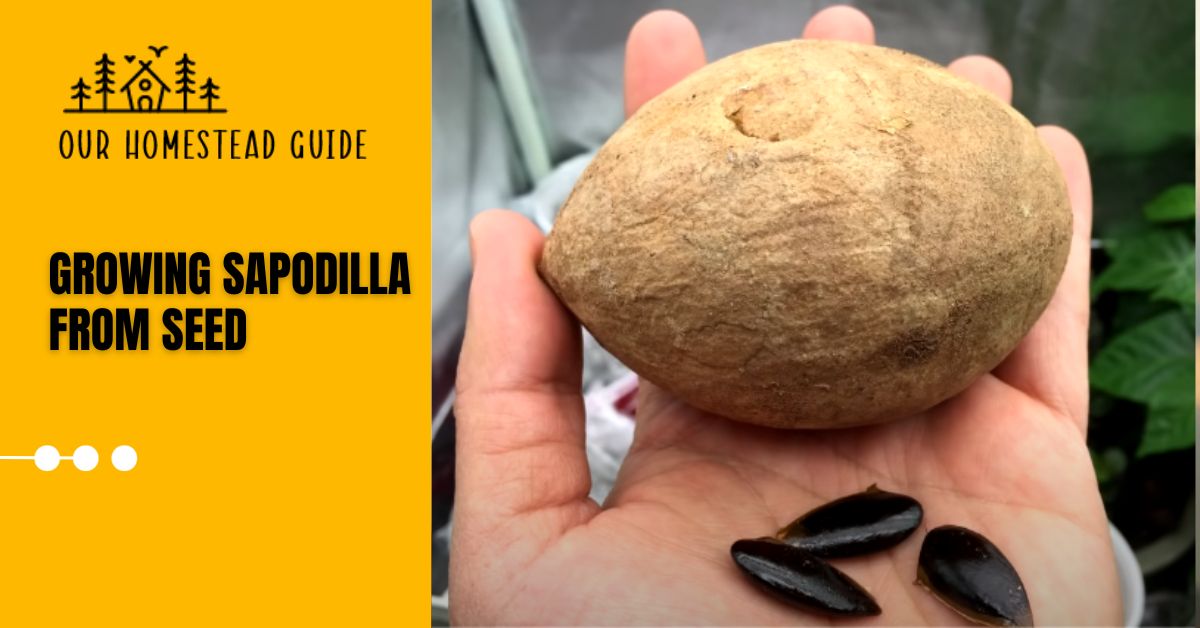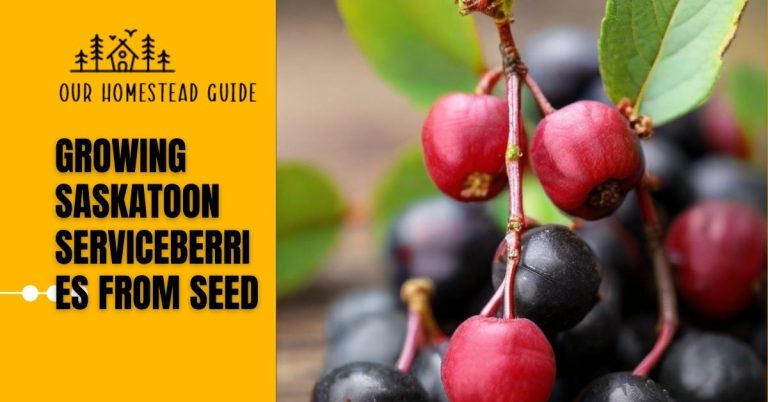Tips for Growing Sapodilla From Seed: Step by Step
Growing Sapodilla From Seed The tropical fruit tree known as the sapodilla, or Manilkara zapota in technical jargon, produces wonderful, sweet fruits. You’ve come to the correct site if you’re interested in starting a sapodilla tree from seed at home.
This detailed guide will take you step-by-step through the procedure while offering helpful advice, pointers, and serving suggestions for your homegrown sapodilla harvest.
How to Growing Sapodilla From Seed?
Step 1: Choosing the Right Container
- Next, add a balanced potting mix, especially one made for tropical fruit trees, to the container. For each sapodilla seed you intend to plant, make a little depression in the dirt that is approximately an inch deep.
- Sapodilla seeds should be gently inserted into the depressions and covered with dirt. The container should be thoroughly watered to maintain the soil constantly wet but not soggy. Your sapodilla seeds will rapidly germinate and develop into strong sapodilla trees if you are patient and attentive.
Step 2: Gathering Your Supplies
Sapodilla seeds, well-draining potting soil, a large container with adequate drainage, a watering can, and access to a sunny area are all necessary for growing sapodilla trees from seeds effectively. Growing Sapodilla From Seed Pick a suitable container first, then fill it with potting mix, making sure it has the ideal soil composition for tropical fruit trees.
Next, gently plant each sapodilla seed by making a small depression, and then thoroughly water the container. To offer the essential sunshine for a sapodilla seedling’s healthy growth, put it in a sunny location. Growing Sapodilla From Seed You’ll be well on your way to growing your sapodilla seeds into healthy trees if you have these necessary equipment and circumstances.
Step 3: Preparing the Seeds
Sapodilla seeds must be carefully prepared before sowing by being free of any meat or trash. To begin, gently rinse the seeds under running water to get rid of any pulp that is still on the sapodilla seeds. To remove any obstinate particles, you may alternatively use a soft brush or cloth.
Use a fresh towel or paper towel to pat the seeds dry once they have been cleaned. Now that the seeds have been cleansed, you may plant them in your well-draining potting soil to improve the likelihood of successful germination and development.
Step 4: Potting and Planting
- Choose a suitable container and fill it with a well-draining potting mix, making sure there is enough room for the seeds. This will start the process of planting sapodilla seeds. The sapodilla seeds should be separated from one another within one-inch deep indentations that you make in the soil.
- Water the soil well after planting to ensure that it has the right amount of moisture for germination. A wet soil might harm seedlings, so take care not to overwater. You may quickly see your sapodilla seeds sprout and grow into healthy sapodilla trees with the right care if you keep the soil consistently moist and keep the container in a bright place.
Step 5: Providing Proper Care
- Light from the sun: Set the container in a bright area where the sapodilla seeds will be exposed to direct sunshine or strong, indirect light. Sapodilla trees require a lot of light for good growth because they like the full sun.
- Soil Moisture: Growing Sapodilla From Seed Maintain a constant soil moisture level, but watch out for waterlogging and root rot by not overwatering. Between waterings, let the top inch of soil somewhat dry out. Check the soil’s moisture level frequently by sticking your finger there; if the soil feels dry there, it’s time to water.
- Fertilization (Optional): To promote healthy development, you can choose to use a balanced fertilizer during the growing season. Use a slow-release or water-soluble fertilizer designed for fruit trees and apply it as directed by the manufacturer.
Step 6: Sapodilla Growth
- Sapodilla trees can take many years to develop and start producing fruit, so growing them does need patience. Growing Sapodilla From Seed Normally, it takes a sapodilla tree between 5 and 8 years to mature and start producing fruit. It’s crucial to maintain the appropriate circumstances and care throughout this period as discussed before.
- You could discover that your sapodilla tree outgrows its original container as it develops. Consider moving it to a bigger pot with suitable soil and drainage if this occurs. You might even grow it in your garden if your environment allows it and you have an appropriate outdoor area. Make careful to pick a spot with well-draining soil that receives full light.
Information Table:
| Nutrient | Amount per 100g |
| Calories | 83 |
| Carbohydrates | 19.97g |
| Dietary Fiber | 5.3g |
| Sugars | 14.84g |
| Protein | 0.44g |
| Fat | 0.58g |
| Vitamin C | 14.7mg (25% DV) |
| Potassium | 193mg |
Notes:
Tropical areas with mild temperatures and no frost are optimum for sapodilla tree growth. Growing Sapodilla From Seed For them to thrive and healthily produce fruit, several conditions are necessary.
It’s crucial to keep in mind while planting sapodilla trees that while it is feasible to start them from seeds, it may take them a lot longer to develop fruit than trees grown from grafted saplings. Fruit-bearing trees can usually be established more quickly and reliably using grafted saplings.
Sapodilla trees may grow to be fairly huge, thus it’s also important to prepare for their future growth. Whether you want to keep the tree in a container or plant it in your garden, make sure you have enough room for it to grow to its maximum size comfortably.
Growing Sapodilla From Seed You may successfully grow sapodilla trees and take advantage of its sweet and delectable fruit in a tropical or subtropical location by taking into account these variables and offering the proper care and circumstances.
Nutrition:
Fruit from the sapodilla tree is not only tasty but also healthy. Growing Sapodilla From Seed It offers several essential nutrients that are good for your health:
Dietary Fiber: Sapodillas are a wonderful source of dietary fiber, which promotes regular bowel movements, aids in digestion, and may also make you feel fuller, which may help you control your weight.
Vitamin C: Growing Sapodilla From Seed is an antioxidant that strengthens the immune system, encourages good skin, and aids in wound healing. Vitamin C is present in this fruit.
Potassium: Growing Sapodilla From Seed Sapodillas are abundant in this necessary element, which helps to maintain normal blood pressure and heart function.
Vitamins and minerals: It also includes trace levels of calcium, iron, vitamin B6, vitamin A, and vitamin B6.
Natural Sugars: Growing Sapodilla From Seed Sapodillas are a better alternative to manufactured sweets since they are naturally sweetened with sugars like fructose and sucrose.
Serving Ideas:
You may add the sweet, tropical flavor of sapodilla to a variety of foods and snacks. Here are some suggestions for presenting this delicious fruit:
Fresh Snack: Sapodillas are a simple and healthful fresh snack that just requires peeling and slicing. Growing Sapodilla From Seed Even on its alone, the sweet, gritty texture is delightful.
Fruit Salad: For a touch of the tropics, add sapodilla slices to your fruit salads. Growing Sapodilla From Seed It goes nicely with other fruits including berries, mango, and pineapple.
Smoothies: To give your favorite smoothie recipes a distinctive and sweet flavor, blend sapodilla into them. Growing Sapodilla From Seed For a creamy treat, mix it with yogurt, bananas, and a little honey.
Desserts: Sapodilla may be used in a variety of inventive dessert dishes. Growing Sapodilla From Seed Use it in pies, tarts, or sorbets to benefit from its inherent sweetness and unique flavor.
Preserves and Jams: Sapodilla may be made into preserves or jams so that you can enjoy its flavor all year long. Growing Sapodilla From Seed It may be a delectable topping for cheese or a spread for bread.
Chutney made from sapodilla: Growing Sapodilla From Seed Combine sapodilla with sugar, vinegar, and spices to make a tasty chutney. It goes nicely with cheeses and grilled meats.
Conclusion:
growing sapodilla from seed may be a gratifying experience that will let you savor the tasty results of your effort. You may grow your sapodilla tree at home and enjoy the delicious tropical fruits it produces if you have the right patience and care for it.
Most Frequently Asked Questions!
Q: Can I grow sapodilla trees from seeds?
Sapodilla trees may be grown from seeds. It’s crucial to remember that sapodilla trees produced from seeds may take many years to mature and begin bearing fruit.
Q: How long does it take for a sapodilla tree to bear fruit when grown from seeds?
Sapodilla trees that are cultivated from seeds normally require 5 to 8 years to produce fruit. Depending on the growth environment and care, the precise time may change.
Q: Can I grow sapodilla trees indoors in containers?
Sapodilla trees can be grown indoors in pots, yes. Place them where they will receive plenty of light and provide enough room for the tree to expand.
Q: What are the ideal growing conditions for sapodilla trees?
Sapodilla trees do best in warm, tropical environments with direct sunlight or strong illumination. They need to be protected from cold temperatures since they are vulnerable to frost.
Q: Is it possible to grow sapodilla trees in non-tropical climates?
A: Sapodilla trees may be grown in non-tropical areas even though they prefer tropical climes if the proper circumstances are created indoors or in a greenhouse.
Q: Can I speed up the growth of sapodilla trees from seeds?
While you can create ideal circumstances for development, it’s vital to remember that sapodilla trees have a natural growth rate and that trying to dramatically accelerate it may not produce the intended results.
Q: What are the nutritional benefits of sapodilla fruit?
Sapodilla fruit is a wholesome option that provides dietary fiber, vitamin C, potassium, and other nutrients. It has a sweet, somewhat gritty texture that is well-known.
Q: How can I enjoy sapodilla fruit in my diet?
Sapodilla fruit can be eaten fresh as a snack, added to fruit salads, blended into smoothies, or used in a variety of dessert dishes, such as pies and sorbets.
Q: Can I plant sapodilla seeds directly in my garden?
If you reside in an area with the right environment, you may indeed sow sapodilla seeds right in your garden. Make sure the area has the right amount of warmth and sunlight for sapodilla tree development.
Q: Are grafted sapodilla saplings a faster way to get fruit-bearing trees?
In comparison to trees developed from seeds, grafted sapodilla saplings do indeed tend to yield fruit more soon. They are a well-liked option for people who want a quicker harvest.
you may also like this article
Growing Cauliflower in Pots, Care and Tips: step by step guide


